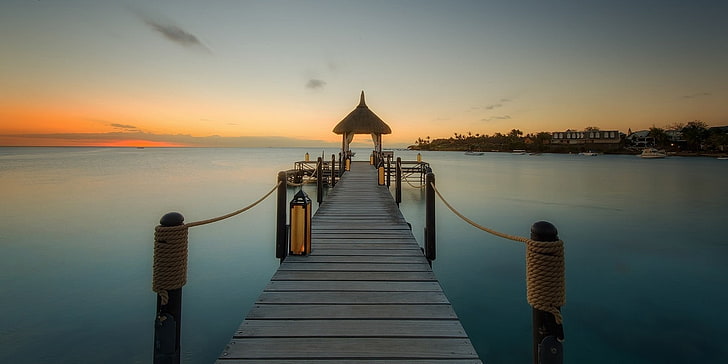
Mauritius Weather Guide: Seasons, Regional Differences & Packing Tips
Planning a trip to Mauritius? One of the most important things to understand before you go is the weather. This tropical island may be small, but its climate varies greatly between the coasts and the inland highlands—and knowing what to expect can make your stay more enjoyable.
In this guide, we’ll explore the two main seasons in Mauritius, how weather differs by region, and most importantly, what to pack for a stress-free island escape.
Season One: Summer (October– April)
- Heat & humidity: Coastal regions see daytime highs of 29–30 °C (84–86 °F), while nights only dip to 24°C. Central plateau, though slightly cooler, still hovers around 22–27 °C
- Rainfall & cyclones: January–March brings intense rainfall—February alone may dump 250 mm (10 in). Occasional cyclones (Jan–Mar) can cause 2–3 days of wetter weather.
- Regional differences: East coast and central highlands bear more showers; west and north coasts stay relatively dry and sunny
What to expect
Expect hot and sunny mornings, often followed by quick tropical showers or thunderstorms in the afternoon, especially in the central and eastern parts. Despite the rain, you’ll still get plenty of sunshine.
Packing tips, Must-Haves:
- Light, breathable clothes (cotton or linen)
- Multiple swimsuits — water activities are endless!
- Flip-flops, sandals, and waterproof shoes
- Wide-brim hat & sunglasses
- High SPF sunscreen (the UV is strong!)
- Compact umbrella or foldable rain jacket
- Light long-sleeved shirt and pants for evenings (mosquito protection)
- Bug repellent (especially inland)
- Dry bag or waterproof phone pouch for boat trips
Bonus for Cyclone Season:
- Power bank (in case of outages)
- Waterproof backpack
- A book or offline entertainment in case of short indoor stays
Season Two: Winter (May – September)
- Temperatures & dry air: Coastal highs are 24–25 °C, cooling to 16–17 °C at night. Central plateau may drop to 13–16 °C
- Winds & rainfall: Southeasterly trade winds (especially June–August) chill the east coast; rainfall drops dramatically—50–90 mm/month
- Regional variations: West coast remains sunnier and warmer; east gets windier but still mild .
What to expect
Perfect weather for sun-seekers and hikers alike: crisp mornings, sunny days, and strong breezes over beaches and hills. Sea temps still pleasant at ~23–24 °C
Packing tips, Must-Haves:
- Layers! Mornings and evenings can be cool
- Light sweaters or a fleece for the central plateau
- Windbreaker or jacket, especially if staying on the east coast
- Closed shoes or hiking boots (great time for nature trails!)
- One or two swimsuits — sea is still warm enough to swim
- Sunscreen and sunglasses — yes, UV is still high
- Long pants and light scarves for cooler nights
Tip: If you’re staying inland or heading into the mountains, it’s often 5–6°C cooler than on the coast — especially early mornings and evenings.
Weather by Region: Coastal vs Central Plateau
Mauritius might be small, but weather can vary dramatically depending on where you are on the island.
|
Region |
Summer (Oct–Apr) |
Winter (May–Sept) |
|
North |
Warmest and driest coast. Ideal for sunbathing and swimming. | Pleasant with plenty of sun. Sea stays calm and inviting. |
|
West |
Sheltered and dry. Rarely gets cyclonic rain. Excellent for sunsets. | Still sunny and warm. Popular for whale watching (July–Sept). |
|
East & South |
More exposed to winds and rain. Green and lush but wetter. | Windier due to trade winds. Popular for kite-surfing and hiking. |
|
Central Plateau (Curepipe, Moka, etc.) |
Cooler and wetter. Afternoon rains are frequent. | Chilly in the evenings. Daytime is crisp and bright. |
When’s the Best Time to Visit Mauritius?
Each season has its charm:
Visit in Summer (Oct–Apr) if you love:
- Lush green landscapes
- Snorkeling, diving, and warm lagoon waters
- Tropical vibes and longer days
Avoid: January to March if you want to completely avoid rain
Visit in Winter (May–Sept) if you prefer:
- Hiking, exploring nature parks, or sightseeing
- Dry, comfortable weather
- Lower humidity and pleasant breezes
Bonus: Fewer mosquitoes and less risk of rain ruining your plans!
Your Packing Checklist
- Summer (Oct–Apr):
ü Light tees, shorts, dresses
ü Multiple swimwear, water shoes
ü Sun essentials + rain jacket
ü Insect repellent
- Winter (May–Sept):
ü Long pants, light sweaters
ü Windbreaker, trainers
ü Swimwear for beach days
ü Sun protection
- Always:
Passport & travel insurance, Type C/G adapter, reusable bottle, camera, basic first‑aid kit & meds
Final Tips Before You Go
- Mauritian weather is very localised — it can be raining in one part of the island while sunny just 10 km away. Don’t be surprised!
- Driving inland? Bring a sweater — the climate shifts quickly as you gain altitude.
- Stay sun-safe year-round — even cloudy days can lead to sunburn.